
Masdevallia, abbreviated Masd in horticultural trade, is a large genus of flowering plants of the Pleurothallidinae, a subtribe of the orchid family (Orchidaceae). There are over 500 species, grouped into several subgenera. The genus is named for Jose Masdevall (?-1801), a physician and botanist in the court of Charles III of Spain.

The Pleurothallidinae are a neotropical subtribe of plants of the orchid family (Orchidaceae) including 29 genera in more than 4000 species.

The orchid genus Dracula, abbreviated as Drac in horticultural trade, consists of 118 species native to Mexico, Central America, Colombia, Ecuador and Peru. The name Dracula literally means "little dragon", an allusion to the mythical Count Dracula, a lead character in numerous vampire novels and films. The name was applied to the orchid because of the blood-red color of several of the species, and the strange aspect of the long spurs of the sepals. The plants were once included in the genus Masdevallia, but became a separate genus in 1978. This genus has been placed in the subtribe Pleurothallidinae.
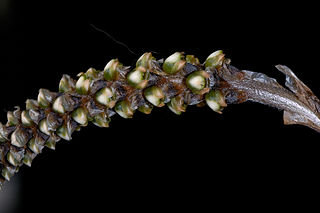
Aa is a genus of plants of the family Orchidaceae.
Black orchid or Black Orchid may refer to:

Dinema is a genus of orchids. It is represented by a single currently accepted species, Dinema polybulbon, native to Mexico, Central America, and the Caribbean.
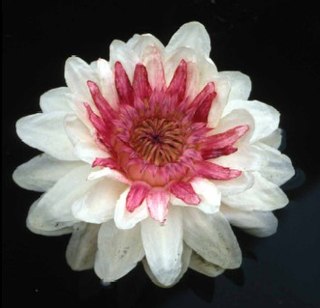
The Flora of Colombia is characterized by over 32,000 species of green plants.

Dracula vampira is an epiphytic orchid species, endemic to Ecuador.

Dracula trichroma is a species of orchid found in Colombia, Western South America, Southern America and Ecuador. It is in the sub tribe of Pleurothallidinae which is within the tribe of Epidendreae. It is also in the sub family of Epidendroideae.
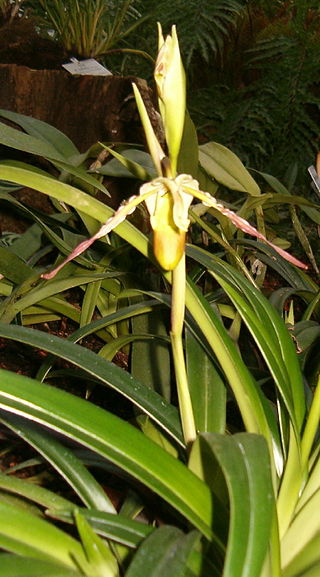
Phragmipedium longifolium is a species of orchid ranging from Costa Rica to Ecuador. Phragmipedium longifolium is a herb found natively in the coastal and Andean regions of Ecuador, among other surrounding countries.

Vanda cristata is a species of orchid found growing in the Himalaya from Bangladesh, India, Nepal, Bhutan to China at elevations of 600 – 2300 meters.
Bulbophyllum lichenoides is a species of orchid in the genus Bulbophyllum. This plant is non-poisonous. It is found in New Guinea on trees in range forests at elevations around 800 meters as a mini-miniature sized, warm growing epiphyte with barely noticeable, cylindrical pseudobulbs carrying a single, apical, patent, oblong, obtuse leaf that blooms in the late winter and early spring on an erect, short to 0.12" (3 mm) long, single flowered inflorescence.

Bulbophyllum phalaenopsis is a species of orchid in the genus Bulbophyllum.
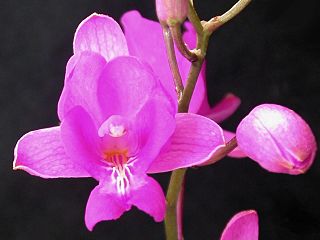
The tribe Epidendreae of the Orchidaceae, within the subfamily Epidendroideae. It includes six subtribes, approximately 120 genera, and over 6,000 species. Popular among orchid collectors, it features well-known genera such as Laelia, Cattleya, and Encyclia, as well as smaller species like Dracula, Dryadella, Masdevallia, and Restrepia.

Chondrorhyncha is a genus of flowering plants from the orchid family, Orchidaceae. At the present time 7 species are recognized, though many more names have been proposed. All species are native to Colombia, Venezuela and Ecuador.
- Chondrorhyncha hirtziiDodson - Ecuador
- Chondrorhyncha ineditaDressler & Dalström - Colombia
- Chondrorhyncha macronyxKraenzl. - Colombia
- Chondrorhyncha panguensisDodson ex P.A.Harding - Ecuador
- Chondrorhyncha roseaLindl. - Colombia, Venezuela
- Chondrorhyncha suareziiDodson - Ecuador
- Chondrorhyncha velastiguiiDodson - Ecuador
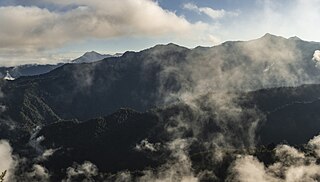
The Bellavista Cloud Forest Reserve is a 2,000-acre (8.1 km2) certified conservation area on the North-Western slopes of the Andean mountain range and is located 52 km from the Ecuadorian capital city of Quito. The lodge itself comprises guest rooms, 10 km of walking trails and the four storey geodesic dome, which contains a restaurant, viewing platforms and further accommodation. The Reserve was first established in 1991 by a British/Colombian couple. The area won the Audubon Christmas Bird Count for the Americas in 2006, 2007, and 2008.

Dracula wallisii is a species of orchid belonging to the genus Dracula. The species is found at altitudes of 1,600 to 2,600 m in Cordillera Central, Colombia. It is a common species, with large flowers that are often highly variable in form.

Dracula simia, known also as the monkey-like Dracula, is an epiphytic orchid originally described as part of the genus Masdevallia, but later reclassified as part of genus Dracula. The arrangement of column, petals and lip resembles a monkey's face. The plant blooms at any season with several flowers on the inflorescence that open successively. Flowers are fragrant with the scent of a ripe orange. The monkey orchid is native to the cloud forests of Ecuador, Peru, and Colombia. Although it was first documented in Ecuador, its natural habitat extends across these three countries. Currently, this orchid is in danger of extinction due to habitat destruction and over-collection.

Stelis gracilis is a species of leach orchid, which is one of the largest genera in the orchid family, with over 600 species. Stelis gracilis are small epiphytes with greenish-white flowers in raceme inflorescences. This rare species of orchid is found in tropical rainforests in North and Central America. It was first described by the American botanist Oakes Ames in 1908.

Quito Botanical Garden is a park, botanical garden, arboretum and greenhouse of 18,600 square meters in the city of Quito, Ecuador. It houses species of plants of the country.


















